These sisters can act - and sing and dance as well
By John Shand, Michael Bailey, Peter McCallum and Joyce Morgan
SISTER ACT
Capitol Theatre
August 11
Until October 26
Reviewed by JOYCE MORGAN
★★★★
Good heavens, when those sisters let rip they would wake St Peter.
Sydney’s second major musical opening within days is an exuberant comic romp – a sisterhood-is-powerful tale rooted in a 70s disco sensibility. It’s the mirror opposite of Hamilton, with its rap music and labyrinthine story of America’s founding fathers.
Sister Act requires a star turn to work. And, praise be, Casey Donovan delivers as the flashy, brassy singer turned reluctant nun.
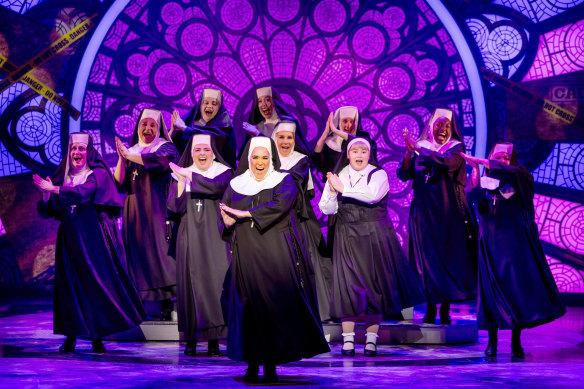
Sister Act’s plot is as thin as a page from a hymn book but it is propelled by upbeat music and strong direction.Credit: Daniel Boud
Donovan has taken on the role portrayed by Whoopi Goldberg in the popular 1992 movie from which the musical was developed.
Although the musical premiered in London’s West End in 2009, this is its first Australian staging. The production will tour nationally.
Set in late 1970s Philadelphia, Deloris Van Cartier (Donovan) is the wannabe disco diva with a gangster-boss boyfriend.
When she inadvertently witnesses him shoot an errant underling, she goes on the lam and is sent for her own protection to a nunnery.
There, she trades her purple high-heeled boots and sparkly mini dress for a nun’s habit. But she can’t trade her loud-mouth, bad-gal habits. Much to the disapproval of the stern Mother Superior (Genevieve Lemon). And that’s the prime source of the comedy in this fish-out-water tale.
Deloris takes charge of the convent’s caterwauling choir. And what miracles she works as she transforms the choir and herself.
The story is as thin as a page from a hymn book – and runs out puff in the second act – but it is propelled by upbeat music as well strong direction by Bill Buckhurst, who has directed the revival currently playing on the West End.
While the movie relied on extant songs, the musical features original disco, Motown and gospel-style music by leading Disney animation composer Alan Menken (The Little Mermaid, Beauty and the Beast, Aladdin). He is aided by Glenn Slater’s witty lyrics and book by Cheri and Bill Steinkellner (Cheers).
There are some memorable numbers, not least Fabulous Baby! and Raise your Voice, and the ensemble of nuns do them justice.
Donovan’s performance is assured. She can belt out a bluesy number but rein in her powerful voice with control and clarity.
For Deloris’s transformation to hit the mark, she must convince as the initial bad ass who redeems herself. Donovan does that.
With her dry wit, Genevieve Lemon is an acerbic Mother Superior whose prayers for a saviour for her struggling convent are answered in a mysterious way.
Rhonda Burchmore makes the most of her role as off-beat senior nun Sister Mary Lazarus, although she has scant material to work with.
Raphael Wong as Eddie – the police officer with a crush on Deloris – was a standout with I Could be that Guy. His transformation from daggy cop to disco king and back entailed an astonishing on-stage costume change. It was a moment of theatrical magic.
James Bryers is a splendidly swaggering gangster boss Curtis, especially in his When I Find My Baby as he makes clear his intentions to snuff out Deloris. It’s a lyrically violent song cunningly disguised as a straight love ballad.
Curtis’s goons, TJ (James Bell) Pablo (Jordan Angelides) and Joey (Tom Struik) were a delightful comic trio and their close harmonies in Lady in the Long Black Dress felt like a Bee Gees parody.
Sophie Montague as novice nun Sister Mary Robert delivered a heartfelt The Life I Never Led.
Under a halo of lights, Morgan Large’s attractive design cleverly transforms the stage from nightclub to gothic cloisters, while his costumes in the finale provide a dazzling conclusion.
Sister Act won’t leave you blinded by divine light, but you might be uplifted in the knowledge that the sisterhood triumphs. Amen to that.
THE CHERRY ORCHARD
Old Fitz Theatre, August 11
Until August 24
Reviewed by JOHN SHAND
★★★★
Playwright Gary Owen takes Chekhov’s The Cherry Orchard, pulls it up by the roots, poaches the characters in the story’s juice, and relocates it to an apple orchard in 1982 Thatcherite Wales. Unlike the Ensemble’s concurrent Uncle Vanya, Owen’s play is more “inspired by” than “adapted from”.
It’s also very funny. Seven cousins of Chekhov’s characters are recognisable in their interrelationships and mostly even their names. The matriarch of this crumbling slice of the upper-class cake is now Rainey, and she’s such a committed drinker that a sighting of her without a glass seems like a sleight of hand.
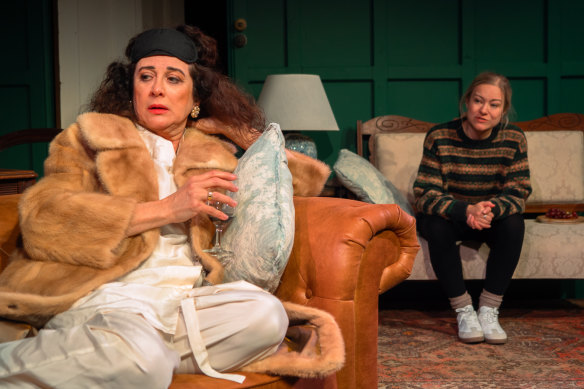
Deborah Galanos’ Rainey is rarely seen without a glass in her hand.Credit: Braiden Toko
In a role to cherish, Deborah Galanos employs every strand of her hair and pore of her skin. While the drunken antics make Rainey primarily comedic, she’s more complex than that: wickedly acerbic, sharp-witted (despite the booze), easily bored and relentlessly supercilious.
She drinks to dull the pain of the long-ago loss of her little boy and subsequent loss of her husband, but there isn’t enough wine in the world for that. She also drinks to blunt the irritation of having triple the intelligence of most of those around her.
Expertly directed by Anthony Skuse, this Secret House production boasts several fine performances. Especially engaging is Talia Benatar’s Dottie, the uppity maid who’s been with the family since a girl. She shares a bond with Rainey that the latter can’t have with her daughters because they’ll never be her lost son, and yet the confines of class cruelly bonsai this bond, with neither able to express all they feel.
Chekhov’s Gayev becomes asinine Uncle Gabriel, whom actor Charles Mayer ensures has a hint of pathos while being treated by all as inconsequential. Amelia Parsonson shrewdly dissipates her initial fizzing presence as Rainey’s daughter, Anya, and Jane Angharad is intermittently too soft as Valerie, the frazzled adopted daughter. Dorje Swallow is both boorish and creepy as Lewis, the self-made man with eyes for the main chance and for levelling the score, and James Smithers (who also designed the admirable set) excels as Ceri, the firebrand Bolshie, seething with resentment and lust.
Owen’s humour is less gently satirical than Chekhov’s; more hard-hitting. While his ending meanders more, the play’s absorbing in its own right, and skilfully realised. He just should have called it The Apple Orchard to differentiate it.
Freddie De Tommaso in concert
Joan Sutherland Theatre
August 11
Reviewed by PETER McCALLUM
★★★★
Since stepping in, mid-show, to a performance of Tosca at Covent Garden in 2022, Freddie De Tommaso has been hailed as a rising tenor of his generation. In this concert, however, he presented himself, with pianist Kate Johnson, as a tenor of Enrico Caruso’s generation, singing neglected arias by Tosti, Giordano, Ponchielli, Cardillo and others, popularised a hundred years ago at the beginning of the recording age.
He began Tosti’s Marechiare with a voice of robust fruity richness, which bloomed freshly in the middle register. The dying fall at the cadence had a hint of melodrama, and he lingered on the descending refrain with outpourings of amiably confected feeling.
The characteristically ornamented turns which end each line in I te vurria vasa by Neopolitan composer Eduardo di Capua, had beguiling, lightly coloured tang and he rose to a splendidly burnished top A with magnificent intensity at the close without strain. Then came a bracket of more familiar music by Puccini and Verdi (including Recondita armonia from Tosca, the first act aria which he presumably didn’t get to sing in 2022 since he took over at interval), more sentimental songs by Tosti and Giordano’s dramatic aria from Fedora, Amor ti vieta.
To conclude the first half he was joined by soprano Alexandra Oomens (not mentioned in the program but currently appearing as an impertinently confident Despina in Opera Australia’s production of Mozart’s Cosi fan tutte) for a duet from Mascagni’s forgotten opera L’amico Fritz. The pitch between them was good, the chemistry perfect.
The second half traversed similar repertoire and, although this music has melodic charm, direct communicative appeal, and winningly exploits the sweet spots of the voice, over-repetition tends to draw attention to some its failings, including a tendency to return to the same melodic shapes and moods over and over again.
Perhaps a different style after interval might have been appropriate. De Tomasso finished with two arias that allowed greater dramatic force at the close, Tu, ca nun chiagne! by Ernesto de Curtis and Cardillo’s Core ’ngrato. In the closing phrases of the Cardillo number, his power was striking and impressive. His encore, Arthur Sullivan’s The Lost Chord was once sung by Caruso at a memorial for victims of the Titanic and introduced a change of language and a mood of cloying Victorian religiosity. It was a program that whetted the appetite to hear De Tomasso in full-blooded role in a fully staged opera.
Maxim Vengerov in Recital with Polina Osetinskaya
Opera House Concert Hall
August 10
Reviewed by PETER McCALLUM
★★★★★
Violinist Maxim Vengerov plays with a creamy tone of polished grain and majestic breadth whether ruminating in the questioning idea in the first of Prokofiev’s Five Melodies for Violin and Piano, or scaling the peaks of tumultuous aspiration in the climactic moments of the finale of Cesar Franks’ Violin Sonata.
Standing centre stage, legs widely spaced to maintain unshakable balance even in passages of the wildest virtuosity, extraneous movement is minimal. The left hand carefully calibrates micro-movements over the finger board to create impeccable intonation, the right hand melds the bow to the string with steely focus, so that all the energy is channelled into the glowing sound welling to the farthest corners of the Concert Hall.
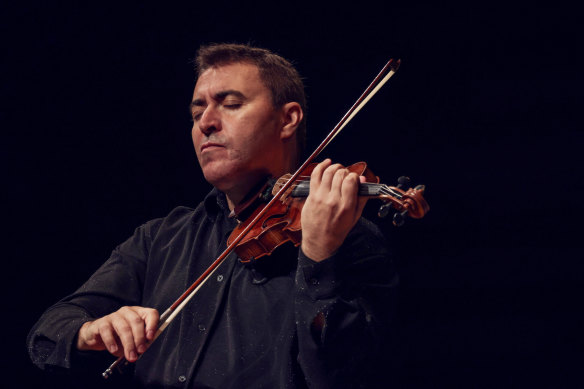
Vengerov’s glowing sound wells to the farthest corners of the hall.Credit: Nicole Cleary
Partnering with pianist Polina Osetinskaya, and playing the whole program from memory, Vengerov devoted the first half to the music of his compatriot, Prokofiev, with whose music he revealed thoughtful empathy.
The Five Melodies moved through reflection, rippling transparency, turbulence, playfulness and expressiveness, ending with a line of wispy harmonics of quietly gleaming clarity. Osetinskaya began Prokofiev’s Violin Sonata No. 1 in F minor, Opus 80 with well-controlled menacing softness in the depths of the piano and both players held the tension right to the closing passages of evanescent ghostly scales.
For the spiky hammered ideas of the second movement, Vengerov’s sound maintained strength without a hint of grating bow noise. In the quietly flowing third movement, which Vengerov’s violinistic forebear, David Oistrakh, played at Prokofiev’s funeral, Vengerov created high silvery moments of ethereal quietness while the fourth movement was wildly vigorous until the windswept idea that closed the first movement returns, now seemingly at peace.
In the second half, Vengerov and Osetinskaya held the narrative thread that connects the four movements of Cesar Franck’s Violin Sonata with compelling expressiveness. Osetinskaya led off as though drawing a thought from darkness before Vengerov took up the story with rich line, carefully graded in intensity. The up-tempo speeds in the urgent second movement and the lyrical finale created challenges in terms of maintaining clarity in the great gales of notes Osetinskaya dispatched from the piano part.
Over this tumult Vengerov soared with radiant power. Vengerov began the G-string solo section at the beginning of Ravel’s Tzigane as though dragging a mighty weight from the instrument with a tone of tensile strength before dispatching the second part with daredevil virtuosity delivered with deft coolness and a twinkling wink. After four encores, the audience was persuaded to leave.
MATTHEW OTTIGNON
Goethe-Institut, August 9
Reviewed by JOHN SHAND
★★★★
Flying is miraculous not because of altitude, speed, precision or aerodynamics, but because of earth and gravity. So in creating music to celebrate birds and flight, Matthew Ottignon ensured airiness and velocity are only part of the equation: he also often grounds the music in grooves and weightier textures, so the impression of flight is not observed, but is experienced and exhilarating.
Launching his new album Volant (Earshift Music), the composer and saxophonist reassembled the quartet that made it for the first time since its recording a year ago. They’d be dangerous if they could do it more often. Pianist Lauren Tsamouras, bassist Hannah James and drummer Holly Connor are fully alive to Ottignon’s desired balancing of lightness and mass, so the drums might crunch while the piano floats, for instance, or the saxophone might soar high above an earthy rhythm.
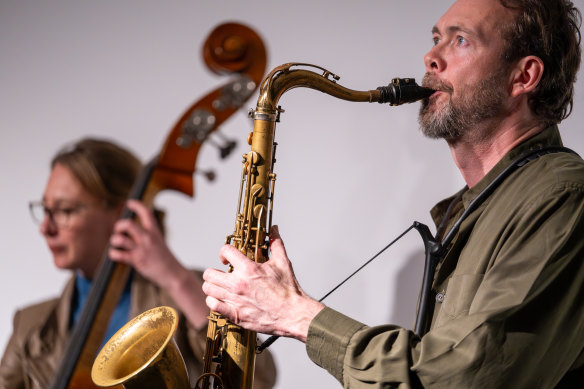
There are hints of giants such as John Coltrane and Pharoah Sanders in Ottignon’s lines.Credit: Barnabas Imre
The opening Moon Rock had Ottignon’s alto glancing off the Goethe-Institut’s bright but sympathetic acoustics, while the band lit flares around it. Naturis was more contemplative, beckoning a brooding solo from James, while Connor stretched time by playing behind the beat, whereas on The Third Bardo, she perforated the storming tenor’s density.
Murmuring seemed the project’s very essence, with the tenor wheeling and swooping over the updraught of the evolving intensity of the others’ eighth-note ostinato. Rocky Lux was simultaneously driving and weightless, culminating in an exultant four-way dialogue, while for the incendiary Bilpin, Ottignon swapped to baritone, making a vast, majestic sound, and Tsamouras again played dancing lines that did much to lend all the music its buoyancy.
The tenor came to the boil over the free-jazz blaze of Rolling and Circling, and to the Volant material they added Jet-Setters, which was like funk with tripwires attached, featuring a jolting feature from Connor.
Through it all came hints of the spirit of such monumental figures as John Coltrane and Pharoah Sanders, but Ottignon’s artistry is too far advanced for you baldly to hear the sounds or lines of the forebears who helped shape him.
Ride and Mercury Rev
Enmore Theatre, August 9
Reviewed by MICHAEL BAILEY
★★★★ (Mercury Rev), ★★★½ (Ride)
As the mostly middle-aged audience took their seats for this double bill, several punters were overheard to declare they were “only here” for one band or the other.
It’s true that a Venn diagram of the subsequent performances by Ride, the Oxford shoegazers, and Mercury Rev, the dream poppers from Buffalo – their heydays 35 and 25 years ago respectively – would have few intersecting elements.
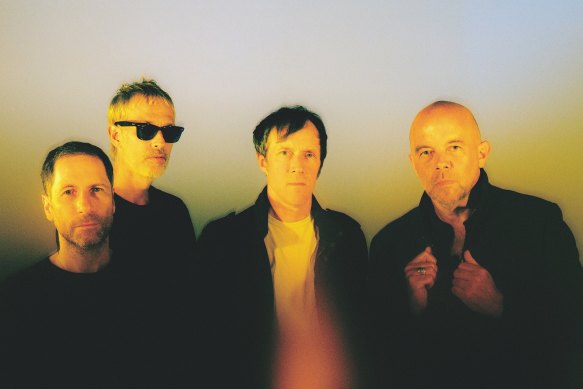
Ride were pioneers of the early-’90s shoegaze movement.
They both gave us lots of effects-driven guitar, a sprinkling of indie radio hits and a willingness to mesmerise, if we’d close our eyes and let them.
As to who swayed most new fans from the other side, the showmanship and sweeping melodies of Rev pipped the tightness and intensity of Ride.
Mercury Rev are the ostensible ’“support act” for this Australian tour so they came on first, although what happened next made a revolving headliner situation seem more appropriate.
For a band always so serious on record, frontman Jonathan Donahue had a surprisingly playful stage presence. He conducted the five-piece with enthusiastic hand gestures, added blasts of harmonica and hand-held synthesiser, and at one point commandeered the drums during a set just seven songs long yet transporting.
Much of that transcendence was down to Holes and The Dark Is Rising, two of the turn-of-the-century’s most shimmering ballads. The 58-year-old’s high notes still did them justice, as did stately keyboard playing from Marion Genser, and on the latter – mysteriously dedicated to Aussie band Died Pretty – a dramatic end that had Donahue silhouetted as if ascending to a heaven suggested by the roiling music. It was two minutes to match anything I’ve seen on stage.
It was a tough act to follow for Ride, so they instantly set the moshpit alight with the night’s highest tempo tune, Monaco, from this year’s seventh studio album.
It was still easy to hear why Ride were at the vanguard of the short-lived shoegaze movement. Their set was akin to a wall of sound, Andy Bell’s guitar by turns jangling and buzzsawing, weaving around Steve Queralt’s motorik bass and Loz Colbert’s martial drumming while Mark Gardener’s vocals prized mood over meaning.
The layered arrangements and limited sonic palette did, however, make highlights hard to pick from the general head-nodding goodness.
The strummed riff of Vapour Trail got the room swaying as one – it remains shoegaze’s signature moment – and the new Peace Sign showed they can still write an infectious pop tune a la Twisterella, while the synth-assisted Leave It All Behind was an explosive encore, Gardener bellowing for the ages.
An agreeable ride, then. But it was Mercury Rev that took us on a journey.